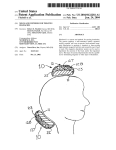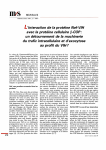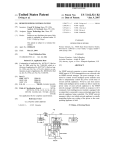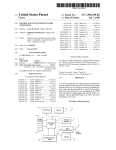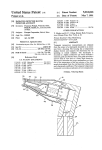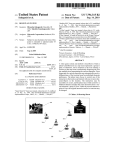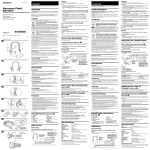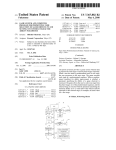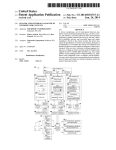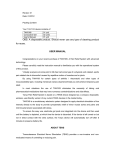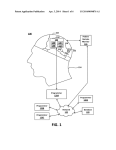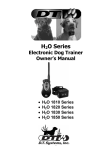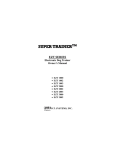Download Means and methods for treating headaches
Transcript
US007294101B2 (12) United States Patent (10) Patent N0.: (45) Date of Patent: Fischell et al. (54) MEANS AND METHODS FOR TREATING HEADACHES 5,725,471 A *Nov. 13, 2007 3/1998 Davey et al. 6,132,361 A * 10/2000 Epstein et a1. .............. .. 600/13 6,162,166 A * 12/2000 Neuwirth ................... .. 600/14 6,402,678 B1 * 6/2002 Fischell et a1. ............. .. 600/13 2004/0138097 A1* 7/2004 Guyuron ...................... .. 514/2 (75) Inventors: Robert E. Fischell, Dayton, MD (US); David R. Fischell, Fair Haven, NJ (US); Adrian R. M. Upton, Dundas US 7,294,101 B2 (CA) (73) Assignee: Neuropace, Inc., Mountain View, CA (Us) Notice: Subject to any disclaimer, the term of this patent is extended or adjusted under 35 Filed: This patent is subject to a terminal dis claimer. Hallet, M., “Transcranial Magnetic Stimulation and the Human Brain,” Nature, Jul. 13, 2000, vol. 406, pp. 147-150. * cited by examiner Primary Examinerilohn P. Lacyk Dec. 21, 2002 (57) Prior Publication Data US 2004/0122281 A1 ABSTRACT Jun. 24, 2004 Disclosed is a system and method for treating headaches. Int. Cl. A61N 2/04 (52) (58) Boroojerdi, MD. et al., “Reduction of Human Visual Cortex Excitability Using l-HZ Transcranial Magnetic Stimulation,” Neu rology, Apr. 2000, pp. 1529-1531. (65) (51) Barker, A.T. et al., “Non-Invasive Magnetic Stimulation of Human Motor Cortex,” The Lancet, May 11, 1985, pp. 1106-1107. U.S.C. 154(b) by 691 days. (21) Appl. No.: 10/327,163 (22) OTHER PUBLICATIONS The system employs a self-contained, battery operated, readily portable and easy-to-operate head-mounted mag (2006.01) U.S. Cl. ...................................................... .. Field of Classi?cation Search ............ .. 600/13 600/9il5; 607/1, 3, 45, 68, 71472 See application ?le for complete search history. (56) References Cited netic depolariZer to generate a transient or time-varying high-intensity magnetic ?eld into and around the user’ s head or neck. The magnetic depolariZer system can be used to depolariZe the neurons of the brain and/or the trigeminal nerve. This type of neuronal depolarization has the capabil ity for terminating migraine or other types of headaches. U.S. PATENT DOCUMENTS 5,483,111 A * 1/1996 KuZnetsov ................. .. 310/12 28 Claims, 4 Drawing Sheets U.S. Patent Nov. 13, 2007 Sheet 1 014 FIG. 2 US 7,294,101 B2 U.S. Patent Nov. 13, 2007 Sheet 2 of4 US 7,294,101 B2 U.S. Patent Nov. 13, 2007 Sheet 3 of4 US 7,294,101 B2 28 16 21 18A 18B U.S. Patent Nov. 13, 2007 Sheet 4 of4 US 7,294,101 B2 US 7,294,101 B2 1 2 MEANS AND METHODS FOR TREATING HEADACHES certain effects (e.g., depolariZation and discharge) of brain neurons. This type of system has been given the name Transcranial Magnetic Stimulation (TMS). If repetitive magnetic pulses are applied in this manner, it has been given the name rTMS. In the journal Neurology (Apr. 11, 2000, pp. 1529-1531) it has been reported by B. Boroojerdi, et al, that FIELD OF USE This invention is in the ?eld of medical devices for the treatment of headaches by the application to the head and/or rTMS at a rate of one pulse per second can create a reduction neck of magnetic ?eld pulses. of the excitability of the neurons of the human visual cortex. In US. Pat. No. 6,402,678, Which is included herein by BACKGROUND OF THE INVENTION reference, Fischell et al. describe the use of one type of system for the prevention or treatment of migraine head aches using one or more high intensity magnetic pulses that depolariZe the neurons of the cerebral cortex. HoWever, the Fischell et al patent does not describe speci?c systems and There are many types of headaches that a?lict the human population. Migraine headaches cluster headaches, tension headaches and sinus headaches all cause serious pain and even disability. Moreover, migraine headaches occur in methods for stimulation of the trigeminal nerve and its associated autonomic nervous system function. Further more, the Fischell et al patent makes no mention of stimu approximately 11% of the population in the US. and West ern Europe each year, and more than 2.5 million persons in the US. have at least one day of migraine per Week. Approximately 80 million additional people suffer from other types of severe headaches in the US. Although neW 20 lation of the neck or the use of a system that has one portion of the system located on the patient’s head or neck that is connected to a separate poWer source by electrical Wires. drug therapies emerge each year, some patients cannot ?nd relief With any existing drug therapy, and some therapies cause signi?cant side effects. A non-invasive, non-drug SUMMARY OF THE INVENTION method for preventing or treating migraine and other severe headaches Would be a remarkable boon for those millions of 25 people all over the World who suffer from these painful experiences. Migraine is Well knoWn to be a neurovascular disorder that, in addition to pain, is characterized by autonomic nervous system dysfunction. Although the pain mechanisms invasive, externally applied, portable, self-contained and 30 are not Well understood, it is believed that actions in nerves to dilate, Which causes pain, Which causes further nerve activation. In particular the trigeminal nerve and its associ 35 this process for migraine and cluster headaches. Disrupting this cycle can in some patients be a key to treating migraine and perhaps other forms of headache. It has also been demonstrated that magnetic (TMS) stimulation of the scalp causes alterations of the autonomic balance in the heart as described above is suf?ciently intense so as to penetrate the cranium and stimulate brain neurons and the Wrappings or meninges of the brain; this device is called a Transcranial 40 45 approximately 40% of all migraine patients have some type Recent literature in the ?eld of neurology suggests that there is a correlation betWeen the trigeminal nerve and 50 ZigZags. Over a time period of betWeen 20 and 30 minutes, the pattern enlarges and fades until it extends into the outermost portions of the visual ?eld. During this time trigeminal nerve also supplies motor nerve ?bers for the performed by Dr. Adrian Upton at McMaster University in 55 nate headache pain in a majority of the patients Who have been treated With this therapy. The advantage of TcMS have a visual aura have some other precursor of a migraine compared to rTMS or TMS is that much less poWer is 60 required to stimulate nerves located just beloW the skin (i.e., transcutaneously) than is required to generate signi?cant electrical currents beloW the cranium and into the cerebral cortex. Therefore, one embodiment of the present invention is a means and method for stimulation of the trigeminal In 1985, A. T. Barker, et al (Lancet, 1985, pp. 1105-1107) described the use of an electromagnetic coil placed over the scalp Which produced a high intensity, time varying, mag Canada have indicated that Transcutaeous Magnetic Stimu lation (TcMS) of the trigeminal nerve can reduce or elimi unpleasant feelings. Many migraine patients Who do not netic ?eld. This magnetic ?eld produces an electric current in the cortex of the human brain, Which can in turn produce headaches of various types. The trigeminal nerve is the large cranial (?fth) nerve that supplies sensation to the face, much of the scalp, meninges and the inside of the mouth. The muscles of the jaW. Preliminary laboratory experiments period, the patient might also completely lose part of his that can be perceived from minutes to hours before the actual start of the headache. Special techniques may be used to treat patients With aura. neck and to stimulate surface nerves, such as the trigeminal nerve; this device is called a Transcutaneous Magnetic Stimulator (TcMS). mately half of these patients have a visual aura that typically begins as a small pattern of scintillating colored lights that visual ?eld. At the end of this visual aura, most migraine patients have a severe headache that is often accompanied by other symptoms such as nausea, vomiting and other Magnetic Stimulator system (TMS). In another embodiment the time-varying magnetic ?eld created by the system described above is less intense so that it can only penetrate the skin and other surface tissues of the face, head and/or of aura that is a precursor of a migraine headache. Approxi have the appearance of Wiggling Worms or multicolored stimulated and depolarized. The present invention includes methods for using such a portable or non-portable device for treating a variety of types of headache. In one embodiment the time-varying magnetic ?eld created by the system measured by changes in the beat-to-beat variability of the heart. Some patients With migraine experience a distinct aura or Warning symptoms before the actual occurrence of the symptoms of the migraine headache. It is estimated that under the control of the patient. The magnetic ?eld pulses extend into the head and/or neck near the site Where the device is applied in such a Way that the local neurons are in the head, brainstem and other tissues cause blood vessels ated autonomic nervous system function seem implicated in The present invention is a system and method for treating and preventing headaches that includes a device for deliv ering one or more intense pulses of time-varying magnetic ?eld to the head and/or neck of a person suffering from headache. In the preferred embodiment, this device is non 65 nerve and its branches by means of one or more magnetic pulses that act upon the neurons of the trigeminal nerve. Both TMS and TcMS systems are referred to herein as US 7,294,101 B2 3 4 depolariZer systems. The depolariZer system is described as self-contained if it can be battery operated, and it is described as portable if it Weighs less than 5 kg. It should be noted that in the limited clinical study cited above, both TcMS and TMS have been successful in stop adapter for providing direct poWer and/ or for recharging the batteries. It Would include the Well-knoWn capabilities of rechargeable systems such as loW battery detection and safe recharging. The poWer module contains the circuitry needed to deliver poWer to the magnetic ?eld generators capacitors. ping headaches that had lasted for many hours and that Were not successfully treated With medication. The present inven tion also includes the method of using a non-portable TMS The control module might be enclosed in the same housing as the magnetic ?eld generator or it might be separate. It Would typically contain the electronic devices needed to control the amplitude, number, frequency and duration of the magnetic pulses delivered by the device. In addition it Would include the patient operated sWitch that is or TcMS device to treat or prevent headaches. One embodiment of this invention is a means and method for the treatment of migraine headaches for those patients Who experience a distinct aura before the actual occurrence needed to turn the device on and oif and deliver magnetic of the symptoms of the migraine headache. The visual aura is a result of the spatial progression of a band of brain cells pulses. It Would also include any display devices that Would that are excited in that band typically across one half of the brain’s occipital lobe. This band moves in an anterior direction at the rate of approximately 2-5 mm per minute. It is believed that if the advancing band of excited neurons can TcMS system. In one embodiment, the magnetic ?eld generator, control be interrupted before the aura has completed its 20 to 30 minute time duration period, the migraine headache Will not occur. One Way to stop such an advancing band of excited be needed by the patient to facilitate use of the TMS or module and poWer module are all contained in one unit called a single unit depolariZer. In another embodiment of the invention, the poWer module and portions of the control 20 the magnetic ?eld generator by electrically conducting brain neurons Would be by imposing a high enough electric Wires. Thus the head unit portion of the device (Which Would be the magnetic ?eld generator) Would be smaller and lighter current through these neurons or neurons in the path of the advancing band so that they become depolariZed and there fore they are not available to support the spread of the With at least some of the source for electric poWer being 25 advancing band. One technique for electrically stimulating these neurons is by using a TMS device, alone or in combination With TcMS, that is placed over the occipital lobe of the brain so as to stimulate the neurons. These neurons Would then be in a refractory state Where they are 30 less likely to participate in passing on the “aura” event. The device should be placed onto the patient’s head as soon as possible after the patient becomes aWare of a visual (or any located remotely from the part of the system that is placed on the head. The portion of the system With the poWer module and all or part of the control module might be designed to sit on a table top and Will be called the table top unit. Note that other embodiments are possible. The control module functionality can be split betWeen the head unit and the tabletop unit in such a Way as to minimize the Weight of the head unit. In general it is expected that the on-off sWitch Would be located on the tabletop unit and the pulse actuation sWitch could be located on the head unit. other type) aura that is a precursor of a migraine headache. For patients Whose aura originates from a region of the module are in one portion of the system that is connected to 35 Other embodiments of the device might include other cerebral cortex other than the occipital lobe, the depolariZing device can be applied to the corresponding region of the divisions of functionality betWeen the portion that is placed head. The one pulse per second of rTMS described by separate unit. Boroojerdi, et al, Which Was proven to cause a reduction of on the patient’s head or neck and the portion that is in a Thus, an objective of this invention is to treat headaches, 40 trical current in a portion of the patient’s cortex by applying a very strong magnetic ?eld by means of a depolariZer system that includes a magnetic ?eld generator placed close cerebral cortex excitability, could be applied to break up the advancing band of excited neurons that is the cause of the visible aura of a migraine headache. Furthermore, a single TMS pulse or tWo to ten individual pulses spaced 2 to 100 seconds apart could also be used to depolariZe the neurons especially migraine headaches, by inducing a transient elec to or onto the head or neck. 45 Another objective of this invention is to treat headaches, of the cerebral cortex to stop an aura from proceeding to a especially migraine headaches, by inducing a small transient full bloWn migraine headache. The magnetic depolariZer system is expected to have a electrical current in a portion of the patient’s trigeminal nerve and associated nerves by applying a strong magnetic ?eld by means of a depolariZer system that includes a magnetic ?eld generator placed close to or onto the head or neck. Another objective of this invention is to prevent the occurrence of a migraine headache by creating a short magnetic ?eld generator, a control module With associated display devices, and a poWer module. The magnetic ?eld generator is the source of the time varying magnetic ?eld pulse. It includes an electromagnetic coil that is required to 50 generate the magnetic pulses. It also typically contains the duration, high intensity, time varying magnetic ?eld by DC to DC converter and the capacitors that are discharged to provide the high level of electric current that is required to produce a high intensity magnetic ?eld pulse. While other 55 means of a magnetic depolariZer system Whose magnetic ?eld generator is placed onto the scalp of a patient Who has shapes are possible, the electromagnet can be formed in a an aura Which is a precursor of a migraine headache, the racetrack, ?gure-eight shape, enclosed in an appropriate magnetic ?eld generator being adapted to cause depolariZa casing, and equipped With a holding means such as a Velcro strap, a handle or enclosed in a helmet. The length of the tion of the neurons in the cerebral cortex Where the aura 60 magnetic ?eld generator Would typically be betWeen Another object of this invention is to have the magnetic ?eld generator placed by the patient onto his or her head or neck at a speci?c location relative to the patient’s cerebral approximately 5 and 15 cm. The poWer module Would typically contain a rechargeable or replaceable (primary) battery to make the system self contained and to help make the system portable. It Would provide the variety of voltages needed for the system. The poWer system is expected to utiliZe a conventional AC originates. cortex, head or neck. 65 Still another object of the invention is to have a magnetic depolariZer system be self-contained and include a poWer module, a magnetic ?eld generator, and control circuitry for US 7,294,101 B2 5 6 creating a high intensity, time varying magnetic ?eld, Where settings of the system’s operating parameters are preset by DETAILED DESCRIPTION OF THE INVENTION a physician or by the manufacturer and the system is operated by means of one or more patient operated sWitches. Still another object of the invention is to have the mag netic depolariZer 10 that has the capability to provide a high FIG. 1 is a top vieW of a portable, self-contained, mag netic depolariZer system be poWered by a rechargeable intensity magnetic ?eld pulse (or train of pulses) for stimu battery. lation of the brain or for stimulation of the trigeminal nerve. Stimulation of the cerebral cortex of the brain Will be referred to herein as TMS, and transcutaneous stimulation of the trigeminal nerve and of other surface nerves of the head and neck shall be referred to herein as TcMS. Both forms of stimulation can use the same type of device; e.g., any of the devices that are shoWn in FIGS. 1-8. HoWever, TcMS Still another object of this invention is to have a self contained magnetic depolariZer that can be held in the patient’s hand and placed over a portion of the patient’s head or neck to stimulate either or both the trigeminal nerve and the cerebral cortex With a time-varying magnetic ?eld as a treatment for an ongoing headache. Still another object of this invention is to have a self stimulation of the trigeminal nerve requires much less poWer than the poWer required for stimulation of the brain by means of TMS. Therefore, the portion of the system that is to be placed on the patient’s head can be smaller and lighter if only TcMS is to be applied. contained device that provides a suf?ciently high intensity, time-varying magnetic ?eld pulse(s) to transcutaneously stimulate the trigeminal nerve, thereby providing a TcMS treatment for a headache. The depolariZer system 10 includes a case 11, a Velcro Still another object of this invention is to have a portable, self-contained, magnetic depolariZer system that consists of a magnetic ?eld generator adapted to be placed onto the patient’s head by the patient and a poWer and control module connected by Wires to the magnetic ?eld generator, Which poWer and control module provides the electrical poWer that is required to cause the magnetic ?eld generator to generate 20 includes circuitry that implements poWer module function ality, magnetic pulse generator functionality and control 25 a high intensity magnetic pulse. Still another object of this invention is for the depolariZer system to be portable. Still another object of this invention is for the depolariZer system to have a display to help the patient in the operation shoWn in FIG. 1. The length of magnetic ?eld generator 30 pulses administered by the patient. 35 and a bottom strap 12B; collectively being a Velcro adjust These and other objects and advantages of this invention able hand belt 12. The tWo straps 12T and 12B are used by the patient to adjust the siZe of the hand hole 22 through Which the patient’s four ?ngers 23 are placed as shoWn in upon reading the detailed description of this invention including the associated draWings as presented herein. FIG. 4. Also shoWn in FIG. 2 are the electronics module 13, the battery 14 and the electromagnet 15 having a Wire BRIEF DESCRIPTION OF THE DRAWINGS Winding 18A. 45 portable magnetic depolariZer system for the treatment of hand hole 22 and the electromagnet 15 having a ?rst coil Winding 18A and a second coil Winding 18B. Although the 50 electromagnet 15 could use an air core (i.e., a magnetic permeability of one) one preferred embodiment of the present invention uses a ferromagnetic core to enhance the generation of the magnetic ?eld pulse. To reduce the mag iZer on a patient’s head or neck. FIG. 5 is a block diagram of the electrical circuitry of the FIG. 3 is a cross section of the magnetic depolariZer 10 at section 3-3 of FIG. 1. FIG. 3 shoWs the case 11, the belt 12 having top and bottom straps 12T and 12B respectively, the FIG. 4 illustrates tWo positions of the magnetic depolar magnetic depolariZer of FIG. 1. FIG. 2 is a cross section of the self-contained depolariZer 10 at section 2-2 ofFIG. 1. The case 11 is preferably a plastic for the hand belt 12. The belt 12 consists of a top strap 12T Will become obvious to a person of ordinary skill in this art headaches. FIG. 2 is a cross section of the magnetic depolariZer at section 2-2 of FIG. 1. FIG. 3 is a cross section of the magnetic depolariZer at section 3-3 of FIG. 1. 5 and 15 cm. The Width of the magnetic ?eld generator might be betWeen approximately 3 and 10 cm and its height in a direction above the skull (not including the Velcro hand belt 12) could be betWeen approximately 1.0 and 5 cm. shell that contains all the parts of the depolariZer 10 except TMS or TcMS from a non-portable or a portable device for the treatment of a headache. FIG. 1 is a top vieW of a single unit, self-contained, functionality. The system 10 also includes a battery 14, an electromagnet 15, a recharging connector 16, an ON-OFF sWitch 19 and a magnetic level setting sWitch 21. FIG. 5 is a block diagram that illustrates the electrical connections betWeen the electrical and magnetic components that are electromagnet 15 Would typically be betWeen approximately of the device. Still another object of the invention is for the system to have control circuitry Which creates a time delay betWeen Still another object of this invention is a method for using adjustable hand belt 12, an electronics module 13 that 55 netic energy lost in a magnetic pulse, the core of electro magnet 15 should be forrned from a ferromagnetic material having a loW hysteresis loss. A preferred version of the FIG. 6 is an alternative embodiment of the invention ferromagnetic core Would be formed from thin laminations having a ?rst part of the magnetic depolariZer Which is a head unit that is a magnetic ?eld generator designed to be to decrease eddy current losses during the magnetic pulse. placed on the patient’s head or neck and a second part that is has poWer and control modules forming a tabletop unit that is connected by Wires to the head unit. FIG. 7 is a top vieW of a magnetic depolariZer having an air core coil for creating the high intensity, time-varying magnetic ?eld. FIG. 8 is a cross section of the magnetic depolariZer at section 8-8 of FIG. 7. 60 Optimally the ferromagnetic core Would also have a high saturation ?ux density and high permeability to create the highest strength of the magnetic ?eld With the loWest amount of energy. Such a ferromagnetic alloy Would be selected from the group consisting of an iron-nickel alloy, a nickel-iron-molybdenum alloy, pure iron or other alloys of 65 iron and/or nickel. An example of one such alloy is vana dium permendur. Also, it is envisioned to use either lami nations of such alloys or poWder metal cores or ferrite cores. US 7,294,101 B2 8 7 FIG. 4 illustrates tWo different positions for the magnetic A su?iciently intense time-varying magnetic ?eld pulse depolariZer system 10 as placed onto the head or neck of a human subject. ShoWn in FIG. 4 are the cross sections of the human ?ngers 23 shoWn betWeen the top of the case 11 and must be created that Would cause neurons to be depolariZed and thereby disrupt the start of a headache. For TMS, the intensity of the magnetic ?eld at the surface of the brain should be betWeen 0.1 and 5 Tesla. For TcMS the intensity of the magnetic ?eld at 1 cm beloW the surface of the scalp should be betWeen 0.1 and 5 Tesla. In both cases the pulse beneath the Velcro belt 12. It is expected that the four ?ngers 23, excluding the thumb, Would be placed betWeen the top of the case 11 and the belt 12. The top and bottom straps of Width of the magnetic pulse should be approximately the belt 12, i.e., the straps 12T and 12B respectively, Would be adjusted by the patient so that his or her ?ngers 23 Would betWeen 0.1 and 5 milliseconds. The frequency rate of the magnetic pulses (if more than one is used) should be ?t snugly into the hand hole 22. It is also conceived that the approximately betWeen 0.1 HZ and 500 HZ. With some magnetic depolariZer system 10 could have a handle (not patients a single, short duration pulse may be all that is shoWn) that Would be held in the patient’s hand as he or she places the device at some location that the patient has found to be effective in treating a headache. It Will be recogniZed required. The magnetic pulses can be applied continuously for a period of betWeen 0.1 and 50 seconds. By applying one or more magnetic ?eld pulses to the neurons of the cerebral cortex and/ or to the neurons in the scalp, many patients Will be able to decrease the intensity and/or duration of a that either a handle or belt straps as described above, or a generic or patient-speci?c molded structure may be used as a positioner to ensure that the depolariZer is placed properly over the patient’s trigeminal nerve. Other positioner struc tures are possible and Will be apparent to a practitioner of ordinary skill in the art. FIG. 5 is a block diagram of the magnetic depolariZer migraine headache. The circuitry for the magnetic depolariZer system 10 can 20 system 10. The rechargeable battery 14 can be recharged through the recharge control circuit 17 and receptacle 16 that system 10 for treatment of a headache. Although FIGS. 1 and 4 shoW a magnetic depolariZer system 10 With a battery, the system 10 could also be operated by plugging into a receptacle at (typically) 115 or can receive a plug from a conventional AC adapter (not shoWn) that transforms AC line voltage (e.g., 115 volts) to an appropriate DC voltage to recharge the rechargeable 230 volts AC. Such a system might or might not use a battery battery 14. An adapter for utiliZing a car or boat 12-volt as part of its circuitry. battery for operating the magnetic depolariZer system 10 is also envisioned. The recharge control circuit 17 provides Well knoWn poWer management capabilities of rechargeable systems such as preventing overcharge, detecting loW bat FIG. 6 shoWs an alternative embodiment of a headache 30 treatment system 40 that utiliZes a tabletop unit consisting of a plug 45, a transformer 47 connected by the Wire to the 44 to the poWer and control module 41. The tabletop unit is connected by an electrical Wire cable 42 to the head unit Which is the magnetic ?eld generator 43. The magnetic ?eld 35 generator 43 Would typically include the capacitor 26, the tery voltage, alloWing operation Without battery When the recharger is available, and timers to automatically power off the system When appropriate. When the patient is experiencing an aura of a migraine electronic sWitch 27 and the electromagnet 15 of FIG. 5. The poWer and control module 41 Would typically include the battery 14, the ON-OFF sWitch 19, the DC to DC converter headache or experiencing a headache itself, he or she can throW the ON-OFF sWitch 19 to the ON position. That Would cause the DC to DC converter 30 to come on and generate a high voltage for rapidly charging the capacitor 26. There 30, the receptacle 16, the recharge control circuitry 17, 40 Would be a suf?cient time delay (e.g., 3 to 10 seconds) betWeen the time that the magnetic depolariZer system 10 is turned on and the time that the ?rst magnetic pulse is 45 28 senses that the appropriate capacitor voltage has been reached, it moves the sWitch 27 from position “A” to position “B” thus discharging the capacitor 26 through the coils 18A and 18B of the electromagnet 15. At the factory or under the control of a doctor a small 50 number (typically one to ?ve) combinations of pulse poWer, pulse train or single pulse and pulse train duration can be programmed into the control circuit 28. The treatment combination Will be selected by the patient using selector sWitch 21. Once the system is poWered on via sWitch 19 and the treatment combination is selected via sWitch 21, the control circuitry 28 Will control sWitch 27 to deliver the desired pulse or pulse train. A tWo to four position sWitch 21 can be used to select from the preprogrammed menu the amount of energy stored in the capacitor 26 and to set a 55 circuitry 28 to control the discharge of the capacitor 26 and the sWitch 27 in the magnetic ?eld generator 43, its Weight and siZe Would be considerably reduced. Furthermore, the high current draWn by the Windings 18A and 18B suggests that an optimum design has the shortest Wire connections betWeen the sWitch 27 and the capacitor 26. The energy lost by heating of the coils 18A and 18B can also be reduced by making the coils out of silver instead of copper or aluminum. Thus, the system 40 shoWn in FIG. 5 can be made to have the lighter and smaller part of the system be the head unit that is placed by the patient onto his or her head. Since the charging of the capacitor 26 Would take place over a time period that is very long compared to the time period of discharge of the capacitor 26 into the coils 18A and 18B, the electric current ?oWing through the Wire cable 42 is reason ably loW. For example, if the capacitor 26 discharges an average of 4,000 amperes into the coils 18A and 18B in 0.5 60 corresponding number of energy levels for the magnetic pulse. The sWitch 27 Would typically be a solid-state con trollable sWitch such as a thyristor that is capable of repeat able sWitching of a high electrical current in a feW micro seconds. As previously described, the coils 18A and 18B message circuitry 24 and the part of the control circuitry 28 having a magnetic pulse energy adjustment sWitch 21. By having only the capacitor 14, electromagnet 15, part of the generated to alloW the patient to position the magnetic depolariZer on the head or neck. When the control circuitry also include message circuitry 24 that can be used (as described in detail beloW) to inform the patient by audio or visual means hoW best to use the magnetic depolariZer milliseconds, and it takes 5 seconds to charge the capacitor, and if the ef?ciency of the process is 50%, then the current through the Wire cable 42 is only 0.8 amperes. This com paratively loW current can be carried by a copper Wire cable 42 that Would be comparatively light and ?exible and Would 65 not develop any appreciable heating. For stimulating only could have air cores or they could use a magnetically the trigeminal nerve, a much loWer level of current Would permeable core. typically be required. US 7,294,101 B2 9 10 It is envisioned that there are several other Ways to circuitry to provide such messages is represented by the distribute functionality betWeen the poWer and control mod ule and the head unit. For example, placing the sWitch 19 on message circuitry 24 in FIG. 5. Typical directions could the head unit or placing the DC to DC converter 30 in the head unit. Also shoWn in FIG. 6 is a cross section of a thin sheet 46 system has been turned on,” (2) “noW place the head piece on your head,” (3) “the ?rst pulse has been delivered,” (4) include any one or all of the folloWing statements: (1) “the “the second (or third, fourth, etc.) pulse has been delivered,” (5) “the last pulse has been delivered,” (6) “the system is noW turned off,” (7) “the battery voltage is loW, please recharge noW,” and (8) “your system is not operating prop of ferromagnetic material that could be surgically placed betWeen the patient’s cranial bone and the patient’s trigemi nal nerve. The depolariZer system could be used With or Without ferromagnetic sheet 46. Such a ferromagnetic mate rial sheet 46 Would alloW a much loWer energy to be used for erly, please consult the user’s manual or call the phone number: 1-999-999-9999.” Status lights could be used the magnetic pulse that causes depolarization of the trigemi instead of or in addition to the visual/audio directions nal nerve. Examples of such a sheet of material Would be described above. 0.001 to 0.050 inches thick by approximately 0.1 to 2 inches Wide and approximately 1 to 5 inches long and curved to ?t snugly over the cranial bone. The ferromagnetic material headache patient, the magnetic depolariZer system 10, 40 or Would optimally have a relatively high permeability and high maximum ?ux density. ent from currently available systems for Transcranial Mag netic Stimulation (TMS). Speci?cally, the inventive concept Also shoWn in FIG. 6 is a Wire 44 and transformer 47 connected to a plug 45 for providing electric poWer for the poWer and control module 41. As stated previously, this recharger system could be used to recharge the batteries or to poWer the system Without the battery in the circuit. The plug 45 could be used to connect to conventional line poWer (e. g., 115 VAC). Altemately cord 44 Without the transformer It should be understood that in order to be useful to a 50 must have several distinct characteristics that are differ of the present invention includes the fact that the magnetic 20 the magnetic depolariZer systems 40 or 50 are readily portable, self-contained, have preset operating parameters 25 use primary batteries such as one to four cells, or it could use FIG. 7 is a top vieW of an alternative embodiment of the present invention that utiliZes an air core electromagnet to that are not completely adjustable by the patient, can be placed on the patient’s head by the patient and are turned on and off by the patient. “Self-contained” is de?ned herein as being battery operated. “Readily portable” can be de?ned as having a Weight of less than 5 kg. The only presently knoWn TMS equipment Which is manufactured by the CadWell company or the Magstim company is operated by a physi 47 could be used to plug into a lighter receptacle of a car, or it could be used With any other appropriate source of electrical poWer. The poWer and control module 41 could rechargeable cells (e.g., nickel metal hydride or nickel cadmium cells). Warning lights on the poWer and control module 41 could be used to indicate When the battery is fully charged and/or When battery poWer is getting loW. depolariZer system 10 and the battery operated versions of 30 cian and not by a patient, has operational parameters that are continuously adjustable by the physician as it is being used (i.e., the parameters are not preset), has a magnetic coil that is placed on a patient by an attending physician, and since the entire system Weighs Well over 10 kg it is certainly not 35 readily portable so as to be With the patient Wherever he or generate the required magnetic ?eld pulse. The magnetic she might need it. ?eld generator 50 of FIG. 7 Would be connected to a poWer and control module (such as the poWer and control module 41 of FIG. 6) by means of a Wire cable 52. ShoWn in FIG. 7 is the outline of an electromagnetic coil 56 Within the depolariZer system 10 Would have operating parameters that are preset by an attending physician using a ROM replace To be most useful for its intended purpose, the magnetic 40 magnetic ?eld generator case 54. A belt 62 having top and bottom straps 62T and 62B respectively Would be used to secure the magnetic ?eld generator 50 around the patient’s ?ngers or a handle could be provided. FIG. 8 is a cross section of the magnetic ?eld generator 50 at section 8-8 of FIG. 7. ShoWn in FIG. 8 are the case 54, the air core electromagnet 56, a capacitor 57, electronics module 58 and the Velcro belt 62 having a top strap 62T and a bottom strap 62B. It is also anticipated that the functionality of the poWer/control unit could be incorporated inside the attributes: the peak intensity of the magnetic ?eld at a distance of 1.0 cm beneath the magnetic depolariZer; the 45 time period of each magnetic pulse; the repetition rate of the magnetic pulses and the total number of pulses to be delivered When the magnetic depolariZer system is turned on. It should be understood that the TMS or TcMS device might have as many as four preset levels that the patient can select by means of the sWitch 21 located on a magnetic 50 depolariZer. Once these parameters are set, the patient Would operate the magnetic depolariZer system by placing it on his case 54. In that case the depolariZer system Would be contained in a single unit. The external Wire connection Would only be needed for recharging or for direct AC poWer. It is also envisioned to have some portion of the system or her head and then turning the system on and then off after the headache has been treated. It is also envisioned that the 10, 40 or 50 include electrical circuitry for providing audio and/or visual directions for the use of the magnetic depo lariZer. These directions Would typically be set up at the factory and could be a function of the setting of sWitch 21. Altemately it is envisioned that system directions and pulse 55 de?nitions could be changed in the doctor’s of?ce by chang 60 system has only one operating level that is preset by the factory or by the patient’s physician. It may be desirable for the patient to turn the system on but a timer Would be used ing a ROM or similar device or by doWnloading instructions or data to a memory device. The message circuit 24 is envisioned to include one or more small speakers and screens to display status messages and instructions. The stored audio directions could be played through the speak ment strategy or any other Well knoWn means. These oper ating parameters can include one or more of the folloWing 65 to automatically turn the system off after a preset period of time. The exact level of intensity of the magnetic ?eld that Would be set by the physician or by the patient Would be determined by trial and error. That is, a level Would be selected that provides the best and fastest relief for the patient as that patient Would determine from the actual use of the magnetic depolariZer. That level may be reset from time-to-time as the results in stopping headaches indicates. Since the aura of a migraine headache might occur at any ers. The visual directions for use can also be stored in a time, and since the patient may have only 20 minutes to use memory chip and presented by an LCD message panel. The the magnetic depolariZer system 10, each patient Would US 7,294,101 B2 11 12 11. The system of claim 1 Wherein the magnetic depolar Want to have a system in relatively close proximity. For example, the patient Would Want to have the system at home, and/or at Work, and/or in his or her car. The magnetic iZer system includes an instruction for informing the human subject on hoW to operate the magnetic depolariZer system. depolariZer system Would optimally be su?iciently portable 12. The system of claim 11 Wherein the instruction includes a message having a message type selected from the group consisting of an audio message type and a visual to be taken With the patient on a vacation or on a business trip. It is also envisioned that the magnetic depolariZer system message type. 13. The system of claim 12 Wherein the message includes at least one phrase selected from the group consisting of: as described herein could be used for the treatment of other disorders such as depression, pain, epilepsy, bi-polar disease “the system has been turned on,” “noW place the head piece on your head,” “the ?rst pulse has been delivered,” “the second pulse has been delivered,” “the last pulse has been delivered,” “the system is noW turned off,” “the battery and other disorders of the brain. Various other modi?cations, adaptations and alternative designs are of course possible in light of the teachings as presented herein. Therefore it should be understood that, While still remaining Within the scope and meaning of the appended claims, this invention could be practiced in a voltage is loW, please recharge noW,” and “your system is not operating properly, please consult the user’s manual or call a speci?ed phone number.” 14. The system of claim 1 further including a ferromag netic piece placed betWeen the cranial bone and the subject’s manner other than that Which is speci?cally described herein. What is claimed is: 1. A magnetic depolariZer system for the treatment of a 20 least some of the neurons of the trigeminal nerve of the headache of a human subject, the system comprising: subject. a readily portable magnetic depolariZer designed for 15. A method for the treatment of a headache, the method placement at a speci?c location onto the head or neck comprising the folloWing steps: of the subject, the magnetic depolariZer having at least one electromagnetic coil that is capable of providing a scalp, Wherein the ferromagnetic piece enhances the inten sity of the time-varying magnetic ?eld used to depolariZe at 25 using a positioner to maintain a magnetic ?eld generator onto the head or neck of a subject suffering from, or about to suffer from, a headache in a desired position time varying magnetic ?eld having a peak intensity at some portion of the subject’s trigeminal nerve of at least 0.1 Tesla and a positioner con?gured to maintain relative to the subj ect’s trigeminal nerve, by the subject the at least one coil in a desired position relative to the himself or herself, the placement being at a location Where the magnetic ?eld generator can create at least trigeminal nerve; electrical circuitry connected to the magnetic depolariZer 30 one magnetic ?eld pulse that has suf?ciently high magnetic ?eld intensity for depolarization of at least for providing an electrical current through the at least one electromagnetic coil, the electrical circuitry also including a subject-operated sWitch for turning on the magnetic depolariZer system the system being turned some neurons of the trigeminal nerve. 35 of time-varying magnetic pulses at the patient’s trigeminal off by a timing mechanism Within the magnetic depo lariZer system. 2. The system of claim 1 Wherein the electrical circuitry of the magnetic depolariZer system includes a battery. 3. The system of claim 2 Wherein the battery is recharge nerve. 40 able. 4. The system of claim 1 Wherein the electromagnetic coil of the magnetic depolariZer has a core comprising a ferro magnetic material, the ferromagnetic material being selected from the group consisting of alloys of iron, alloys of nickel, iron-nickel alloys, iron-nickel-molybdenum alloys, vana 45 50 21. The method of claim 15 further comprising the steps 6. The system of claim 1 Wherein the electronic circuitry is adapted to deliver a plurality of time varying magnetic of causing the subject to turn an ON-OFF sWitch ?rst to the ON position and subsequently causing the subject to turn the 55 7. The system of claim 6 Wherein at least one pulse of the plurality of time varying magnetic pulses has a duration betWeen approximately 0.1 and 5.0 milliseconds. 8. The system of claim 6 Wherein the electronic circuitry is adapted to deliver a sequence of pulses at a rate of betWeen seconds. 19. The method of claim 15 further comprising the step of applying at least one of the sequence of magnetic pulses having a duration betWeen approximately 0.1 and 5 milli seconds. 20. The method of claim 15 further comprising the step of applying poWer to the magnetic ?eld generator With a rechargeable battery. creating the time-varying magnetic ?eld. pulses. 17. The method of claim 15 further comprising the step of applying a plurality of magnetic pulses at a rate betWeen approximately 0.1 HZ and approximately 500 HZ. 18. The method of claim 15 comprising the step of applying a sequence of magnetic pulses for a time period betWeen approximately 0.1 second and approximately 50 dium permedur, a poWder metal magnetic material, and a ferrite material. 5. The system of claim 4 Wherein ferromagnetic material core is laminated to decrease the eddy current loss When 16. The method of claim 15 further comprising the step of turning the magnetic ?eld generator on to create a plurality sWitch to the OFF position. 22. The method of claim 15 further comprising the steps of causing the subject to turn an ON-OFF sWitch to the ON position and subsequently automatically deactivating the 60 approximately 0.1 HZ and approximately 500 HZ. 9. The system of claim 8 Wherein the sequence of pulses magnetic ?eld generator after a time period. 23. The method of claim 15 further comprising the step of causing a physician to set at least one operating parameter of the magnetic ?eld generator. is delivered over a time period of betWeen approximately 0.1 24. A method for using a magnetic depolariZer system to second and approximately 50 seconds. 10. The system of claim 1, Wherein the electrical circuitry is controlled by at least one operating parameter that is preset by a physician. treat a headache in a subject in need thereof, the method 65 comprising: detecting an occurrence of a headache; activating the magnetic depolariZer system; and US 7,294,101 B2 13 generating a time-varying magnetic ?eld having a peak intensity at some portion of the patient’s trigeminal nerve of at least 0.1 Tesla. 25. The method of claim 24 Wherein the magnetic depo 14 measured beloW the surface of one of the scalp or the skin of the neck proximate to the trigeminal nerve. 28. A magnetic depolariZer system for providing transcu taneous magnetic stimulation of the trigeminal nerve of a lariZer system is readily portable and self-contained. 26. The method of claim 24, Wherein the step of detecting human subject, the system having a ?rst portion that is adapted to be positioned external to the patient and is the occurrence of a headache comprises receiving an input capable of generating one or more magnetic pulses and a second portion formed at least in part of a ferromagnetic material that is adapted to be positioned under the skin or from the patient. 27. A self-contained, battery-operated system for reducing the intensity and/or duration of a headache by applying a time-varying magnetic ?eld for transcutaneous magnetic stimulation of the trigeminal nerve of a human subject, the system having an electromagnetic coil designed to create a peak magnetic ?eld intensity of at least 0.01 Tesla When scalp of the patient; Wherein the second portion Will enhance the intensity of any magnetic pulse that is generated by the ?rst portion.












